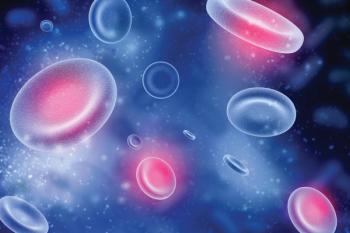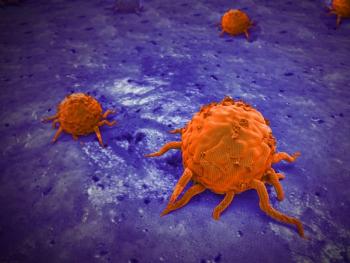
Aumolertinib Has Long-Term Survival Benefit in NSCLC With Brain Metastases
Nonrandomized phase 2 data support further assessment of aumolertinib among patients with NSCLC and brain metastases in a randomized clinical trial.
High doses of aumolertinib, a third-generation EGFR tyrosine kinase inhibitor (TKI), conferred a long-term survival benefit among patients with untreated EGFR-variant non–small cell lung cancer (NSCLC) and brain metastases, according to findings from the phase 2 ACHIEVE trial (NCT04808752) published in JAMA Oncology.1
After a median follow-up of 28.8 months (95% CI, 27.0-29.8), the median progression-free survival (PFS) was 20.5 months (95% CI, 12.0-26.9), which included a 12-month rate of 62.1% (95% CI, 48.7%-73.0%) and a 24-month rate of 40.8% (95% CI, 28.2%-53.1%). With a data maturity rate of 33.3%, the median intracranial PFS was not reached (NR; 95% CI, 22.3-NR); the 12-month and 24-month rates were 76.8% (95% CI, 63.2%-85.9%) and 62.3% (95% CI, 46.9%-74.4%), respectively.
The study treatment elicited a systemic objective response rate (ORR) of 88.9% (95% CI, 78.4%-95.4%) and an intracranial ORR of 82.5% (95% CI, 70.9%-90.9%) across the full analysis set, with data showing a systemic and intracranial disease control rate (DCR) of 100% (95% CI, 94.3%-100.0%). In the central nervous system (CNS) evaluable-for-response group, the systemic and intracranial ORR were 87.8% (95% CI, 75.2%-95.4%) and 85.7% (95% CI, 72.8%-94.1%), respectively.
The median duration of systemic response was 21.4 months (95% CI, 12.9-26.2) across the full analysis set and 20.7 months (95% CI, 9.4-25.9) in the CNS evaluable-for-response group. Additionally, data showed a median duration of intracranial response of 26.2 months (95% CI, 16.8-NR) based on RECIST 1.1 guidelines and 30.6 months (95% CI, 18.7-NR) per Response Assessment in Neuro-Oncology-Brain Metastases (RANO-BM) criteria in the CNS evaluable-for-response group.
“The results of this nonrandomized clinical trial suggest the potential of high-dose aumolertinib as first-line treatment for this population,” lead study author Hui Li, MD, from the Department of Thoracic Medical Oncology at Zhejiang Cancer Hospital, Hangzhou Institute of Medicine (HIM), Chinese Academy of Sciences, wrote with coauthors.1 “The findings of this nonrandomized clinical trial suggest that high-dose aumolertinib treatment is associated with long survival benefit in patients with untreated EGFR-variant metastatic NSCLC and brain metastases, with a manageable safety profile. It deserves further validation in a randomized clinical trial.”
In the multicenter, single-arm, nonrandomized phase 2 ACHIEVE trial, a total of 63 patients were assigned to receive treatment with aumolertinib at 165 mg orally once daily in 28-day cycles until progressive disease, unacceptable toxicity, withdrawal of consent, or death. Additionally, 49 patients accounted for the CNS evaluable-for-response group, which included those with at least 1 measurable brain lesion. Investigators conducted brain MRI and CT scans at baseline and every 8 weeks thereafter.
The trial’s primary end point was the 12-month PFS rate. Secondary end points included intracranial PFS, systemic ORR, intracranial ORR, duration of systemic response, duration of intracranial response, systemic DCR, intracranial DCR, overall survival, and safety.
Patients 18 to 75 years old with histologically or cytologically confirmed advanced NSCLC with brain metastases, tumor tissue samples, or blood samples showing EGFR-sensitive disease, and no prior systemic treatment were eligible for enrollment on the trial.2 Other eligibility criteria included having a stable brain condition for at least 2 weeks before beginning study treatment and an ECOG performance status of 0 or 1.
The median age was 60 years (range, 47-76) in the full analysis set and 59 years (range, 47-76) in the CNS evaluable-for-response group, and most patients in each group were female (61.9% vs 67.3%). A majority of each respective group had an ECOG performance status of 1 (73.0% vs 71.4%), no prior smoking history (73.0% vs 75.5%), stage IVB disease (69.8% vs 71.4%), and extracranial metastases (66.7% vs 67.3%). A higher proportion of patients in the full analysis set had EGFR exon 19 deletion mutations (52.4%), while most in the CNS evaluable-for-response set had EGFR exon 21 L858R mutations (53.1%).
Treatment-related adverse effects (TRAEs) of any grade affected 92.1% of patients; 31.7% experienced grade 3 or higher TRAEs. The most common any-grade TRAEs included increased blood creatine phosphokinase (68.3%), increased aspartate aminotransferase (49.2%), increased alanine aminotransferase (38.1%), and increased blood lactate dehydrogenase (27.0%). Grade 3 or higher TRAEs included elevated blood creatine phosphokinase (27.0%) and increased alanine aminotransferase (3.2%).
Overall, 11.1% of patients experienced TRAEs leading to dose reductions, and 3.2% discontinued treatment due to grade 2 pneumonia. No patients died due to treatment.
References
- Li H, Chen K, Gong L, et al. High-dose aumolertinib for untreated EGFR-variant non–small cell lung cancer with brain metastases: the ACHIEVE phase 2 nonrandomized clinical trial. JAMA Oncol. Published online June 26, 2025. doi:10.1001/jamaoncol.2025.1779
- Almonertinib as first-line treatment in patients with EGFR mutations positive in advanced NSCLC with brain metastases (ACHIEVE). ClinicalTrials.gov. Updated April 22, 2024. Accessed July 31, 2025. https://tinyurl.com/mw9th5jx
Newsletter
Stay up to date on recent advances in the multidisciplinary approach to cancer.




















































































